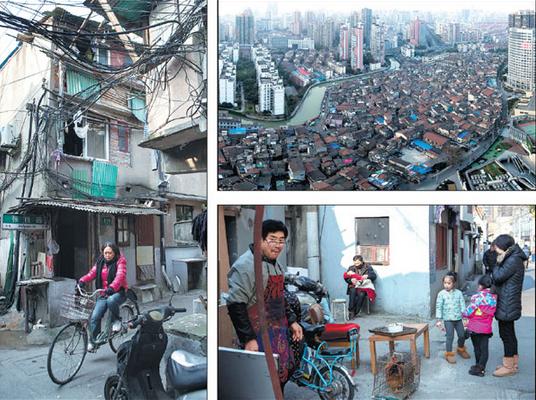
Clockwise from left: A woman rides a bicycle through the narrow streets of the shantytown. Second: An aeriel view of the Zhangqiao area. Third: A man attempts to sell a chicken on the street.
2,100 Shanghai households to be relocated soon
At the entrance of an old, dilapidated residential community in downtown Shanghai, two women were going about their daily business. One of them was washing her hair in a sink, while the other used another sink to rinse out a spittoon.
Most of the residents have installed outside sinks to save space in their small homes, and 40 percent of them don't have indoor bathrooms or kitchens.
Actually, "entrance" is not an accurate description of the portal, because the community doesn't really have an exterior wall, which means burglary is rampant. For some residents, checking the door repeatedly before going to bed has been a habit for several decades.
Welcome to Zhangqiao, Shanghai's largest shantytown. Situated beside a small creek, the community appears as a blemish among the modern high-rise residential buildings worth more than 100,000 yuan ($14,500) per square meter in China's most cosmopolitan city.
Things will change soon, however, because the nearly 2,100 households in the 23-sq-km community in the central Hongkou district will be relocated. In a first-round survey conducted in October, more than 99 percent of residents agreed with the local government's relocation program.
"That's quite rare for an area as large as ours. The residents' decades-old dream will finally come true," said Lyu Xuebin, head of the relocation project, who works for the Jiaxing Road subdistrict of Hongkou.
About 3.5 million sq m of the old city was revamped between 2011 and 2015, when Premier Li Keqiang said the government's goal was to complete the redevelopment of the country's shantytowns by 2020.
In the early 1950s, Zhangqiao was the place where the city's human waste was loaded before being shipped for disposal in remote areas.
Many boatmen, mostly migrants from neighboring provinces, moved ashore and built makeshift single-story houses in the district. As a result, hundreds of buildings of different shapes and sizes sprang up, facing in all directions; a stark contrast to most of the buildings in the city, which stand in neatly regulated lines.
Liu Lihua, who was born in Zhangqiao in 1955, recalled that all the residents lived in single-story houses. "Our ceiling was too low for my father to even stand up straight," she said.
Another resident, Jiang Minli, said his family - two parents and five children - shared a 24-square-meter house when he was young. "My father built an attic of around 7 sq m for us kids to sleep in. There was no running water and the roof leaked," the 65-year-old said.
Liu, her parents and two siblings lived in their 15-sq-m house until the mid-1980s, when her first child was born and the family added two floors to the original structure.
"Most families added a floor when one child got married, then added another when a second child married," she said. Her family installed a kitchen and a bathroom when they renovated their house, but they were the exceptions.
"Many of the roughly 6,000 residents still don't have flush toilets, showers or proper ovens, so most of them use small electric cookers instead," she said.
Overcrowded conditions
Some residents' living spaces remained overcrowded even after their houses grew taller.
A 58-year-old woman, who only gave her surname as Zhang, said 12 people occupy her family's three-story, 50-sq-m house. "Needless to say, the lack of personal space creates chaos and quarrels almost every day," she said. "Another problem is that we don't get any sunlight because the houses are too close to each other."


















































